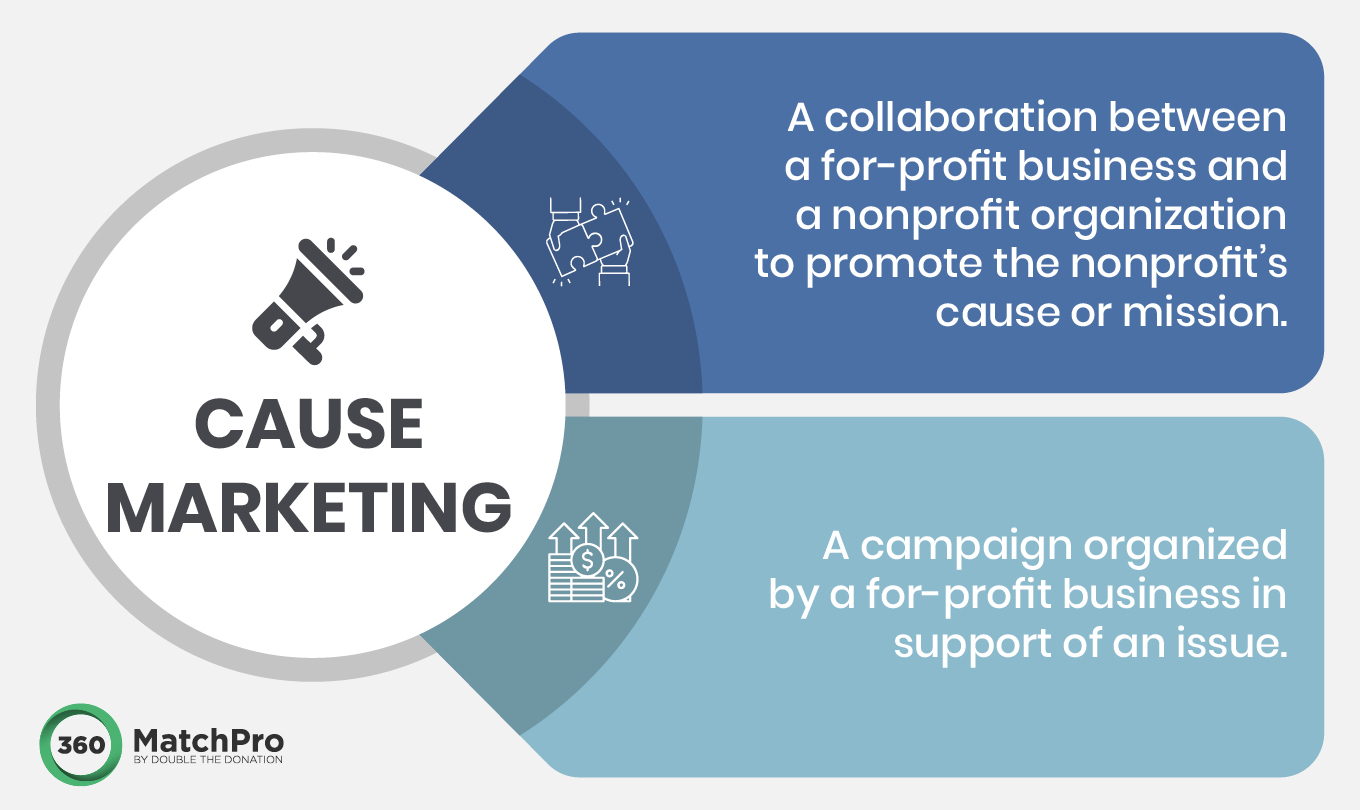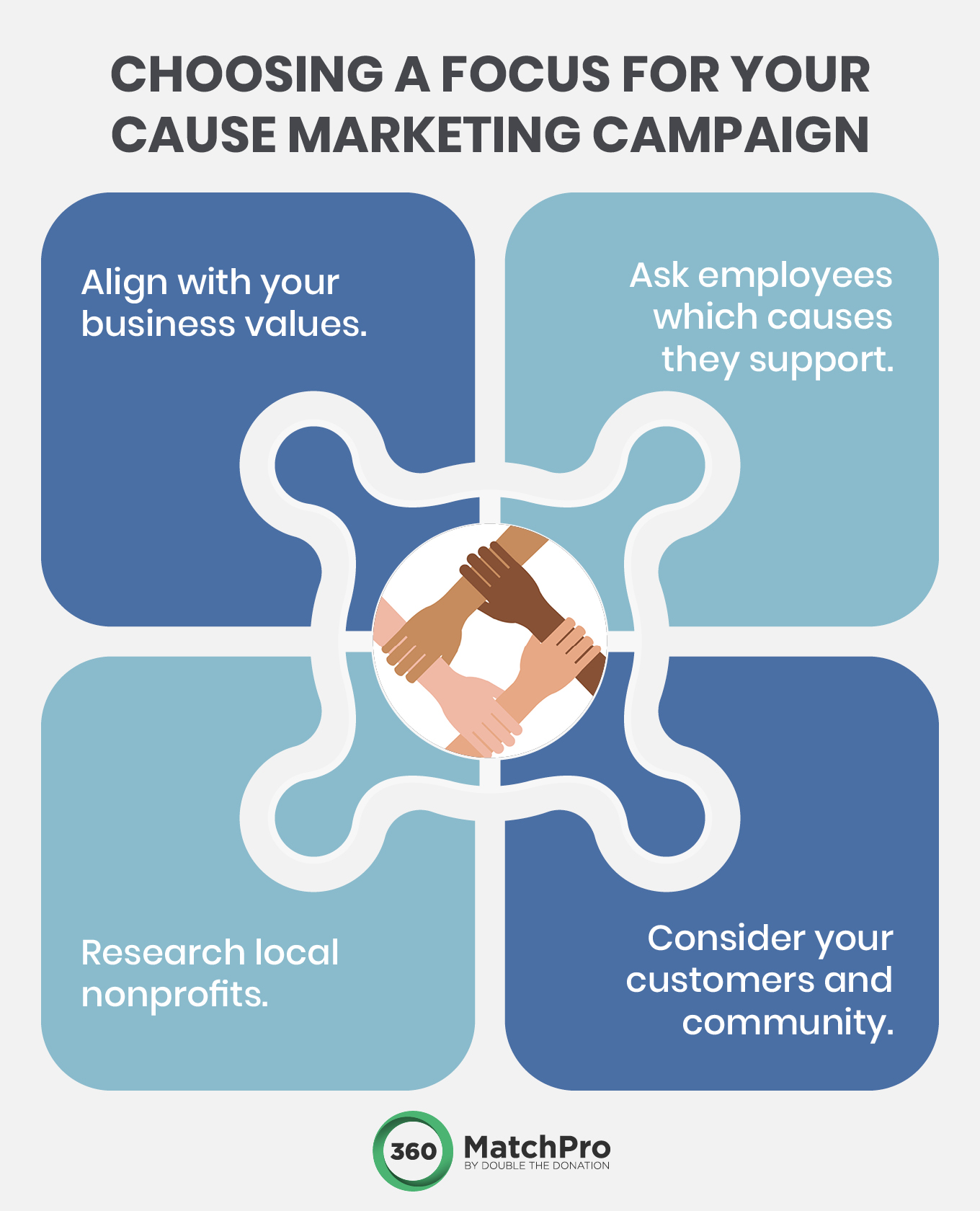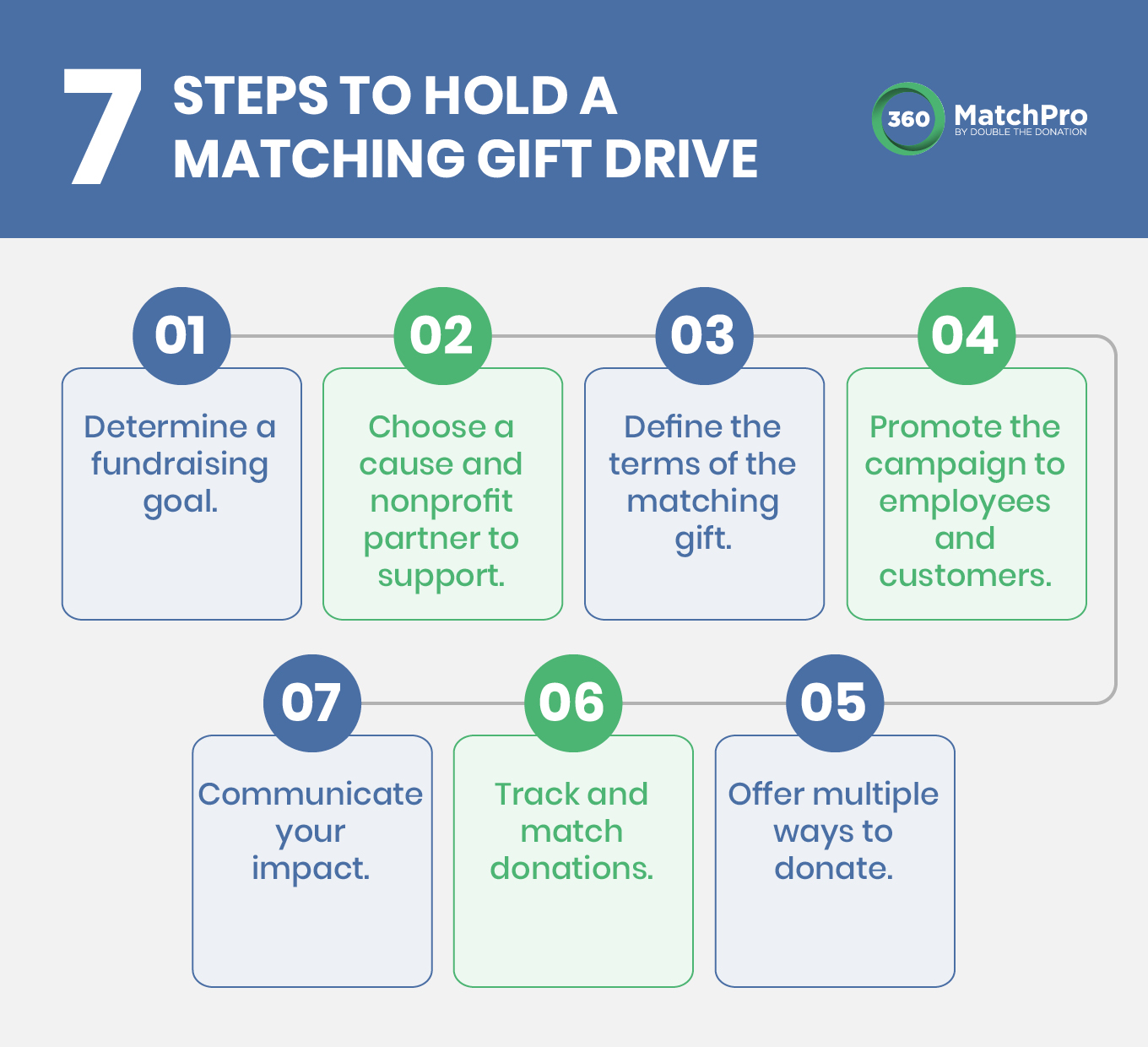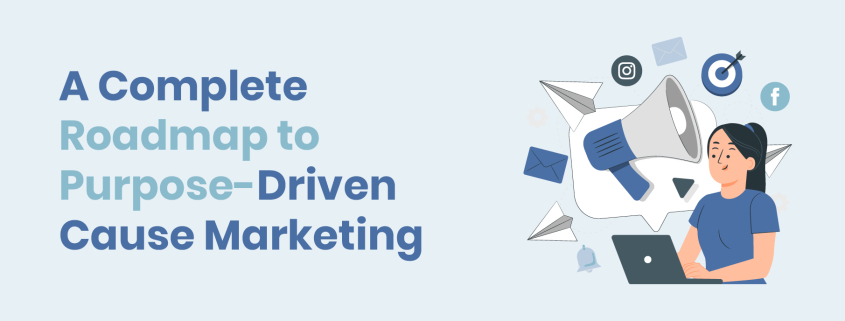A Complete Roadmap to Purpose-Driven Cause Marketing
Corporate social responsibility (CSR) isn’t required from your business, but more and more of your customers and employees expect the businesses they support to contribute to social good. After all, studies show that consumers are four to six times more likely to trust, support, defend, and recommend companies that commit to a strong purpose.
Offering CSR programs like matching gifts and volunteer grants shows your employees that you’re willing to give back to your community—but how do you demonstrate your commitment to social and environmental issues to your customers?
In this guide, we’ll explore the role cause marketing can play in your CSR efforts and how to organize a successful campaign. Let’s get started!
What is cause marketing?
Cause marketing, also called cause-related marketing, can be:

- A collaboration between a for-profit business and a nonprofit organization to promote the nonprofit’s cause or mission.
- A campaign organized by a for-profit business in support of an issue.
For example, a dog grooming business might partner with an animal shelter to encourage people to adopt their pets rather than purchasing them from stores or breeders. There can also be a fundraising component to these campaigns, such as donating a portion of the proceeds from merchandise sales to the nonprofit.
Alternatively, the dog grooming business could organize a solo campaign that centers around a social or charitable cause, such as spreading awareness of unethical puppy mills.
What are the benefits of cause marketing?
Like other CSR initiatives, cause marketing brings a variety of benefits to your business. Some of these benefits include:
- An enhanced reputation. When your business publicly supports charitable causes and organizations, you are showing that you care about bettering your community. This can improve your brand image, instill trust in your customers, boost customer loyalty, and help attract top talent to your company.
- Improved sales. A study showed that 66% of companies that implemented CSR initiatives saw increased sales. Customers want to support businesses that demonstrate their commitment to worthy causes. Additionally, CSR efforts can connect you to new audiences through your partnerships with nonprofits, expanding your customer base.
- More engaged and productive employees. People want to work for businesses that support the causes they care about. By taking their interests and preferences into account, you’ll make them feel happy to contribute to a company that values social good. In turn, they’ll feel more motivated and productive at work.
- A larger impact. Your cause marketing efforts directly impact the issues and nonprofits that you are drawing attention to. You can help them tap into new audiences of your customers and employees, helping them increase awareness of their missions. Additionally, they’ll gain new donors, volunteers, and funding to support operations.
Cause marketing is something your business can do to set itself apart from other companies in your customers’ eyes. If your business isn’t ready to organize a full-fledged cause marketing campaign, consider starting a matching gift program, sponsoring a nonprofit fundraising event, or setting up company-wide volunteer programs for a worthy cause.
How can your business plan a cause marketing campaign?
Planning your cause marketing efforts is similar to any other marketing campaign. You’ll need to set goals, craft a compelling focus and message, select communication channels, and optimize communications for your audience. However, you will need to consider other factors, such as the cause you choose, alongside these traditional marketing steps.
As you organize your cause marketing campaign, make sure to consider these steps and strategies:
1. Carefully choose a cause.
The most important step in your cause marketing campaign is to select a cause that aligns with your values and appeals to your employees and customers. Here are some tips for choosing a cause that makes sense for your business:

- Align with your business values. Choosing a cause that aligns with your values conveys authenticity to your employees and customers. For example, PetSmart’s values include a passion for people and pets, accountability to customers and other stakeholders, and commitment to learning and growing. They highlight their passion for pets with their PetSmart Charities nonprofit that supports shelter animals and facilitates adoptions.
- Ask employees about which causes they are passionate about. Survey your employees to learn which causes and nonprofits they already support. Ask them if they currently donate to or volunteer with any nonprofits. Request suggestions of causes that they and their peers would be most interested in supporting as a business.
- Consider your customers and community. In most cases, you’ll be asking your supporters to help you support a cause by engaging with your company or giving to your partner organization. Make sure this cause will resonate with your audience to garner the most support. Additionally, make sure the issue will not alienate any parts of your audience.
- Research local nonprofits. Exploring the organizations in your area is a great way to understand which causes are relevant to your community. Additionally, supporting these nonprofits will directly benefit members of your local area. These smaller organizations typically need support and funding more than larger groups. For example, if your office is based in Atlanta, you might opt to support the Atlanta Community Foodbank rather than a national organization like Feeding America.
Once you choose a cause, make sure to get buy-in from your company’s leaders, stakeholders, and employees. You may get useful feedback or ideas about the cause you chose, how to be more inclusive, or the best ways to promote the cause.
2. Partner with a nonprofit organization.
If your business takes a more collaborative approach and works directly with a nonprofit, the next step is to select your partner organization. Above all, this should be a collaborative, mutually beneficial effort—in other words, both your business and the nonprofit will have responsibilities and reap rewards.
To keep this relationship running smoothly, start by:
- Setting clear expectations. Agree on specific goals, roles, responsibilities, target audiences, and timelines for the campaign with your nonprofit partner. Work together to create an overarching concept for the campaign as well as a tagline and other campaign messaging. Determine how each brand will be represented (e.g., having each of your logos appear next to each other on branded graphics).
- Having a contract. Having a contract in place protects both parties in the partnership and prevents awkward situations—particularly if money is involved. The contract should document the terms and conditions of the partnership and outline each party’s obligations including the scope of the work, deliverables, and financial agreements.
- Maintain compliance with local regulations. The agreements your business makes with a nonprofit are referred to as commercial co-ventures. These joint ventures must follow specific requirements that can vary by state. Licensing is required for both parties—the nonprofit will need its solicitation registration set up and your business may need to be licensed as a commercial co-venturer. Explore this table to see the licensing requirements for each state.
- Communicating how you will be supporting them. Clearly communicate the specific ways that your business will support the nonprofit through the campaign. This may include financial and in-kind donations, volunteer support, or even pro bono services. Highlight any ways you will work to promote their mission, such as sharing posts about the organization on social media.
Each of these steps helps build a strong foundation for your nonprofit partnership by ensuring trust and transparency. And when both parties clearly understand the goals and individual responsibilities of the campaign, you’ll work together more effectively.
3. Engage your audience.
Next, you’ll need to build a creative campaign that will resonate with your target audience and motivate them to take action. The first step here is to develop a compelling message that communicates the purpose of your campaign and the cause you are supporting.
For example, let’s say your business partners with an organization that aims to preserve local land and native plant species. Your message might be something like “Join us in making a difference! For every purchase you make between now and [Date], we’ll donate 5% to [Nonprofit Name], helping preserve [Town Name]’s wildlife!”
In addition to a clear campaign message, you’ll need to give customers and employees an engaging way to interact with the campaign. Common methods include:
- Percentage of product or service sales: The sample campaign message above is an example of this method. Explain to customers that your business will donate a set percentage of sales to the cause you support—this could be for a specific item or timeframe. To inspire urgency, make this a limited-time offer.
- Round-up programs: When customers make a purchase, ask them if they would like to round up to the nearest dollar and donate the extra amount to the cause. If their total is $20.41 and they round up, the nonprofit would receive $0.59 from the purchase.
- Donation matching: Offer to match your customers’ and employees’ donations to a certain cause or organization up to a certain amount. For example, you might match individual donations up to $100 and donate up to $10,000 total.
- Social media engagement: If your cause marketing campaign is focused more on education and advocacy rather than donations, ask supporters to share about it on social media. Post shareable graphics customers can repost or invite them to participate in a social media challenge or use a campaign hashtag.
- Loyalty programs or coupons: If you have a loyalty program or points system, use it to incentivize customers to donate (e.g., “Get double points for your donation!”). You can also offer discounts or coupons for future products and services to customers who participate.
When promoting your campaign, be sure to use the communication channels that your target audience engages with most often. If you are working with a nonprofit, ask them which platforms usually garner the most engagement among their supporters.
4. Measure and report your impact.
Once your campaign ends, you must measure and share your impact. This helps you and your nonprofit partner maintain transparency and build trust with supporters. In other words, it shows your audience that you make good on your promises.
Your impact report will look different depending on the goal of your campaign. In most cases, your partner organization and supporters will be most interested in:
- Donation amount: Total amount raised by the campaign broken down by source (e.g., customer contributions vs. matches from your company).
- Impact metrics: Quantifiable outcomes of the campaign, such as the number of beneficiaries helped, dogs and cats adopted, houses built, meals provided, etc. Go beyond dollar amounts to make the metrics more tangible.
- Fund allocation: Clearly explain where funding went and how it supported your cause. Consider creating a graphic like a pie chart.
- Campaign reach: How many supporters engaged with your campaign, the number of shares or likes received on social media, website traffic, etc.
If nonprofits and supporters trust your business, you could hold similar campaigns in the future. For example, you might decide to reunite with your nonprofit partner each year. Or, your business could promote the cause during its given affinity month (e.g., raising money for girls in STEM during Women’s History Month).
How can your business get more employees involved?
As we mentioned, your CSR efforts can have a positive effect on employee satisfaction, productivity, and retention. But how can you motivate employees to get involved in workplace giving and engage with your cause-related marketing campaigns? A matching gift drive is a great option.
In a matching gift program, a company agrees to match its employees’ donations to charitable organizations. These matched donations are usually at a 1:1 ratio, meaning that employees can double their impact without any additional financial burden. During a matching gift drive, a company commits to donating a specific dollar amount of matched gifts to a certain cause and often extends the program to customers.
Here is an example of how a business might organize a matching gift drive:

- Determine a fundraising goal for the matching gift drive and the maximum amount you are willing to match.
- Choose a cause and nonprofit partner to support. You could also choose multiple nonprofits to give your employees and customers more options.
- Define the terms of the matching gift, including your match ratio as well as minimum and maximum gift amounts (e.g., matching gifts between $20 and $250 at a 1:1 ratio).
- Promote the campaign to employees and customers. Share internal emails with employees and create email and text campaigns, social media posts, and more with your customers.
- Offer multiple ways to donate to encourage more contributions (Apple Pay, Google Pay, credit and debit cards, etc.).
- Track and match donations. Have an organized, automated system in place to ensure each donation is matched.
- Communicate your impact once the campaign is over.
As we mentioned, your business can also get its customers involved in a matching gift drive to make a larger impact. However, don’t forget to market the opportunity to employees, too—after all, participating in your CSR programs comes with a host of benefits for your business and its employees.
360MatchPro is the leading provider for nonprofits leveraging matching gifts to fundraise, but businesses rely on CSR platforms to facilitate their programs. Look for a platform that partners with 360MatchPro to create the smoothest, most impactful experiences for your nonprofits and employees.
What are some cause marketing examples?
Cause marketing campaigns come in many shapes and sizes. Your business should get creative and choose the best option for its goals, budget, values, and audience.
To help you get inspired, here are some cause-related marketing examples:
Ben & Jerry’s: Pecan Resist
Campaign Overview
Ben & Jerry’s is a Vermont-based ice cream company that has a long history of supporting worthy causes, ethical production methods, and fair pay for employees.
In 2018, the company launched a campaign and ice cream flavor called “Pecan Resist.” The brand defined the campaign as, “a movement to lick injustice and champion those fighting to create a more just and equitable nation for us all.” The flavor was created in response to current political events and aimed to celebrate activists resisting oppression.
Standout Elements
The campaign aimed to spread awareness of issues like oppression and climate change and urged its customers to advocate for the causes they believe in. The company also donated $25,000 to four progressive nonprofits.
The art for the ice cream flavor was designed by artist, activist, and nonprofit director Favianna Rodriguez, and Ben & Jerry’s published an article to celebrate her work and views.
Patagonia: 100% for the Planet
Campaign Overview
Patagonia is an outdoor clothing and supplies retailer. In 2016, the organization launched its “100% For the Planet” campaign on Black Friday. Patagonia promised to donate 100% of its Black Friday proceeds to grassroots organizations that aimed to protect the environment. They also explained that on every other day of the year, they donate 1% of profits to these groups.
Patagonia also has an ongoing “Worn Wear” campaign that allows customers to trade in and buy used items from their brand, reducing the amount of clothing that enters landfills.
Standout Elements
To establish trust and transparency with customers, Patagonia quickly posted an update that summarized the impact of the campaign. CEO Rose Marcario explained that Patagonia reached a record-breaking $10 million in sales, shattering their goal of $2 million.
BoxLunch: Partnership with Feeding America
Campaign Overview
BoxLunch is a specialty retailer that offers licensed and non-licensed merchandise typically geared around pop culture.
The company has an ongoing partnership with Feeding America, a nonprofit dedicated to ending hunger in America. Through this partnership, BoxLunch promises that “every $10 spent in-store or online secures one meal on behalf of local food banks.” So far, the partnership has provided over 175 million meals.
Standout Elements
Depending on pop culture trends, BoxLunch will offer special deals to get fans excited about supporting a worthy cause. For example, the organization created a special Spider-Man figure that is only available at special events. Each figure donates 10 meals to someone facing food insecurity.
BoxLunch also supports various affinity months throughout the year. For example, during Black History Month the business encourages customers to round up to support organizations fighting for racial justice.
Wrapping Up
Cause marketing is a great way to take your company’s CSR efforts to the next level. Whether you partner with a nonprofit, donate to multiple grassroots organizations, or encourage your supporters to advocate for a specific cause, you’ll help make a positive difference.
Leveraging matching gift software will help streamline your efforts and encourage more employee giving during your next cause marketing campaign. Learn more about matching gifts and optimizing workplace giving from these resources:
- Developing a CSR Strategy: 13 Tips for Smart Companies. Cause marketing is just one element of a well-rounded CSR strategy. Check out our tips for developing yours.
- How to Start a Matching Gift Program in 3 Easy Steps. Curious about matching gift programs but not sure where to start? This guide breaks down the how and why of matching gifts.
- How to Improve Employee Engagement: A Complete Guide. Explore the top benefits of having motivated employees and our effective strategies for improving employee engagement.





